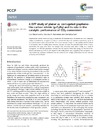Identificador persistente para citar o vincular este elemento:
https://accedacris.ulpgc.es/jspui/handle/10553/75024
| Título: | A DFT study of planar vs. corrugated graphene-like carbon nitride (g-C3N4) and its role in the catalytic performance of CO2 conversion | Autores/as: | Azofra Mesa, Luis Miguel MacFarlane, Douglas R. Sun, Chenghua |
Clasificación UNESCO: | 221001 Catálisis | Fecha de publicación: | 2016 | Publicación seriada: | Physical Chemistry Chemical Physics | Resumen: | Graphene-like carbon nitride (g-C3N4), a metal-free 2D material that is of interest as a CO2 reduction catalyst, is stabilised by corrugation in order to minimise the electronic repulsions experienced by the N lone pairs located in their structural holes. This conformational change not only stabilises the Fermi level in comparison with the totally planar structure, but also increases the potential depth of the π-holes, representing the active sites where the catalytic CO2 conversion takes place. Finally, as a result of corrugation, our DFT-D3 calculations indicate that the reaction Gibbs free energy for the first H+/e− addition decreases by 0.49 eV with respect to the totally planar case, suggesting that corrugation not only involves the material's stabilisation but also enhances the catalytic performance for the selective production of CO/CH3OH. | URI: | https://accedacris.ulpgc.es/handle/10553/75024 | ISSN: | 1463-9076 | DOI: | 10.1039/C6CP02453J | Fuente: | Physical Chemistry Chemical Physics [ISSN 1463-9076], v. 18 (27), p. 18507-18514 |
| Colección: | Artículos |
Citas de WEB OF SCIENCETM
Citations
142
actualizado el 08-jun-2025
Visitas
123
actualizado el 25-ene-2025
Descargas
460
actualizado el 25-ene-2025
Google ScholarTM
Verifica
Altmetric
Comparte
Exporta metadatos
Los elementos en ULPGC accedaCRIS están protegidos por derechos de autor con todos los derechos reservados, a menos que se indique lo contrario.
